skip to main |
skip to sidebar
Events of Friday 28th April 2017
I had to set my alarm for 4.30 a.m. because we needed to leave for the airport at 5.45 a.m. in order to catch the seven o'clock KBZ Air flight K7 262 to Nyaung Oo. This was my first flight from the recently-opened new Domestic Terminal which has a similar design to the existing International Terminal (which replaced the earlier International Terminal which was in use on my first visit to Myanmar in 2008).

Yangon Airport: Using the new Domestic Terminal to fly to Nyaung Oo.
We arrived at Nyaung Oo on time and the monastery car was waiting to take us to Bagan Medical Clinic. Doctor Hla Tun immediately started consultations whilst I was free to explore the busy monastery compound where the various clinic buildings are located. When I checked before lunch, 285 patients had registered. The Friday list had been closed at 250 patients, so the last 35, and subsequent registrations, were placed on the list for Saturday.
Soon, waiting patients were queuing up for the free lunch provided by the monastery. As usual, the abbot started distributing the meals but after a while, he invited me to continue the process.
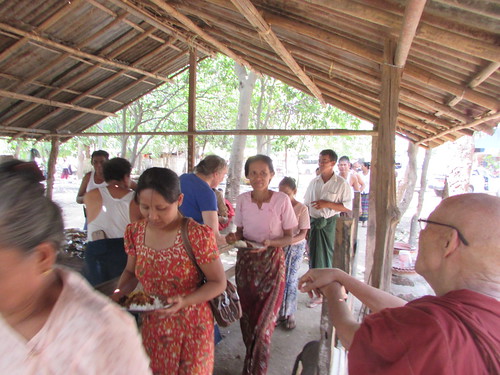
Around Bagan Clinic - Friday: Jan helping to distribute lunches to patients, under the watchful eye of the Abbot.
In a remarkably short time, around 300 lunches had been served, the metal plates and cutlery rinsed by the diners and everything cleared away until the next day.

Waiting patients or their friends washing up after lunch.
A brief tour of the site
I decided to take a walk through the monastery compound looking at developments. It's hard to believe that, in 2010, the whole area now occupied by the clinic was just dusty, beaten earth owned by the monastery. There was no wall or fence around the compound (that's still the case). Back in 2010, the occasional vehicle could be seen, on its way to the monastery itself, the private landing stage on the adjacent Ayeyarwaddy River or passing through to Taung Be village beyond.
Approaching the clinic from the south in 2017, there is now a row of simple stalls on the left to serve the waiting patients, with a couple of tea shops and more stalls on the right.
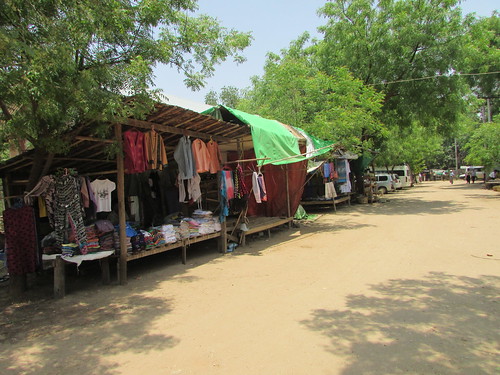
The approach to Bagan Clinic from the south, showing stalls on left of roadway.
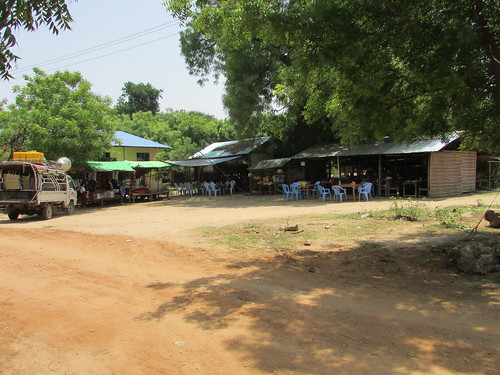
The approach to Bagan Clinic from the south, showing tea shops and stalls on right of roadway.
The next building on the right is of substantial wood frame with block walls rendered and painted. It's part of the clinic, but not medical and serves as a communal dormitory building. Donations from the Ultimate Travel Company in the United Kingdom funded this and other developments. Because of the long distances many patients travel, they often need to spend one or more nights at the clinic before receiving treatment. The dormitory building, simply equipped with raised sleeping platforms, provides basic accommodation for patients and accompanying friends and relatives.

The Dormitory Building for waiting patients.
I then came to the main complex of clinic buildings. On my left, I passed the second clinic building to be erected at Bagan. This large building has a reinforced concrete frame construction, block walls rendered and with a spacious waiting verandah. It houses the clinic's laboratory and a well-equipped physiotherapy department.
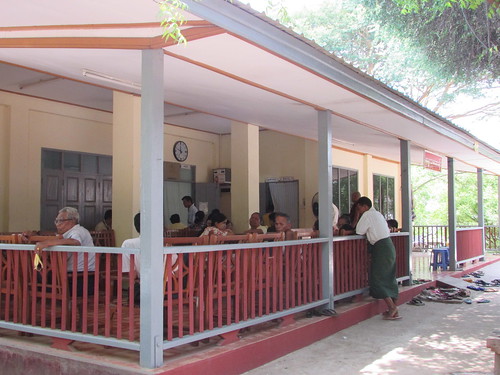
The second clinic building at Bagan is large with a spacious waiting verandah. It houses the clinic's laboratory and a well-equipped physiotherapy department.
In front of the second clinic building is the lofty patient waiting area. This permanent building has replaced an earlier bamboo structure.
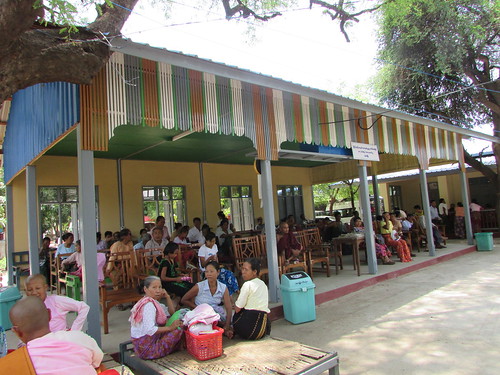
The patient waiting area at Bagan Clinic.
The patient waiting area faces the first clinic building, opened in 2011. There's a report on the early days at the clinic here. The original building has a substantial wood frame with block walls rendered and painted. The structure has been extended by providing a verandah at the front and a covered staff kitchen at the rear.
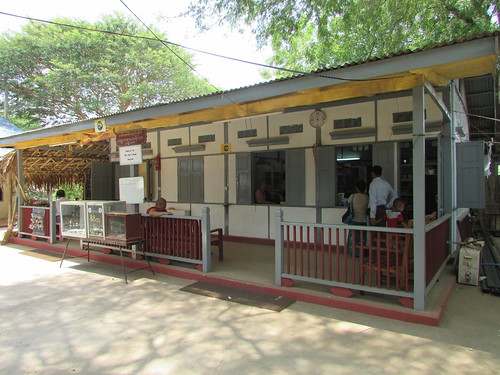
The first Bagan clinic building, showing the verandah which has been added.
Beyond the first clinic building, there's a simple shelter where donations to the work of the clinic are accepted. The concept of charitable giving is an important part of Buddhist beliefs. Next, there's a second, similar shelter currently used by the carpenters engaged on the building extensions. Doors, window frames and shutters are all produced on site to a high standard using hard wood. Experienced joiners carry out this work, principally using hand tools although there is limited use of power tools.
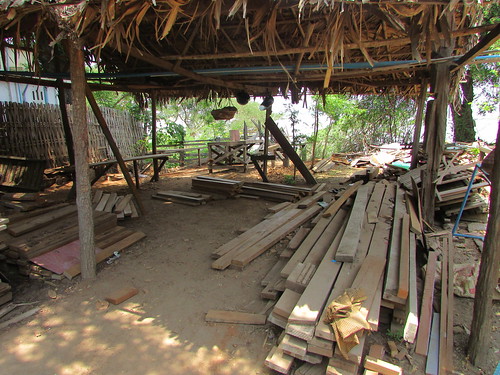
The Joiners' Workshop.
Next, I passed the third clinic building - a slightly larger version of the original building with a substantial wood frame and block walls rendered and painted. There is a verandah at the front and staff toilets at the rear. This building was donated by the Ultimate Travel Company in the United Kingdom
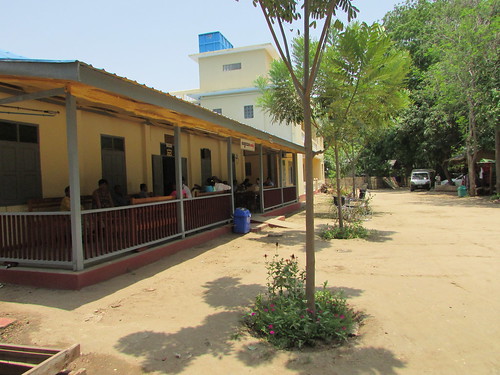
The third clinic building, with Doctor Hla Tun's Consulting Room (left).
This building has a large consulting room with three examination/treatment beds used by Doctor Hla Tun. Myanmar does not embrace Western ideas of privacy and three patients at a time are dealt with in this room, with Doctor Hla Tun moving from patient to patient. Where simple procedures can be dealt with by one of his assistants, the Doctor will attend to the next patient whilst his assistant carries out the work. More complex procedures are always performed by Doctor Hla Tun himself. If laboratory tests are required, the patient will take an order form to the laboratory (situated in the second clinic building), returning to Doctor Hla Tun later with the results. In this way, Doctor Hla Tun can see around 90 patients in a gruelling, whole-day shift.

Around Bagan Clinic: Doctor Hla Tun at work.
Having passed the third clinic building, the impressive fourth clinic building draws the eye. This large, two-storey building has been built to allow the range of treatments provided by the clinic to be further extended. Because of the site conditions, adjacent to the east bank of the Ayeyarwaddy River, extensive reinforced concrete foundations were required. The building itself has been constructed to high standards, to allow X-ray facilities and operating theatres to be accommodated. At the time of my visit, the building itself was still being completed but opthalmology, dentistry and bedrooms for visiting doctors were already in use. A number of donors have provided financing for this important development.
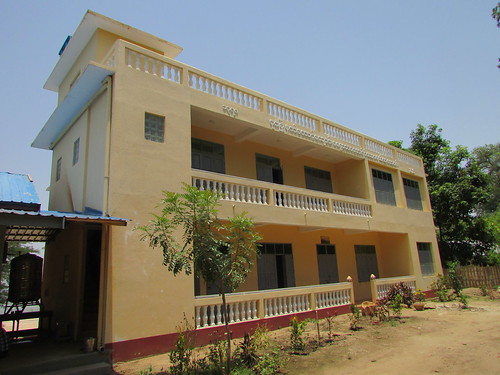
The fourth clinic building nearing completion.
There was one further building under construction, just on the landward side of the two-storey building. This is also a two-storey building of reinforced concrete which will provide a 28-bed hospital unit.

Around Bagan Clinic: End view of Hospital Building under construction, showing main entrance.

Hospital Building Ground Floor Plan.
The growth of the Bagan Medical Clinic since its modest beginning in 2011 never ceases to amaze me. It testifies to the pressing need for better medical care in Myanmar and to the generosity of donors both in Myanmar and around the world who have supported the work.
Related Posts on this Website
Next Post describing this trip.
All 2017 Trip posts.
My Pictures
Where necessary, clicking on an image above will display an 'uncropped' view or, alternately, pictures from may be selected, viewed or downloaded, in various sizes, from the album listed:-
Yangon Airport.
Around Bagan Clinic - Friday.
[Text added, pictures added to text: 21-Jul-2017, 27-Jul-2017]
Events of Thursday 27th April 2017
After the exertions of the previous few days, I decided on a quiet morning at the Doctor's house in Yangon, blogging and backing up pictures ready to upload when possible.
The Doctor's wife had learned that coverage of our Distribution to children in Hlaing would be in the Sky Net television news programme sometime between ten and eleven so I moved my computer to the room with a television and waited with the Doctor's wife, carrying on working on the computer until the item came on.
The segment was about six minutes long and featured two interviews with local staff followed by lots of pictures of the distrbution itself with a voice-over commentary.
In the afternoon, the Doctor and I went to the Belmond Governor's Residence Hotel in Taw Win Road for a meeting with Eddie Teh, General Manager Belmond Myanmar Hotels and Cruises, to discuss the Belmond Myanmar Foundation (of which I am a trustee). Eddie is a strong supporter of the work being carried out and has very clear ideas on the way ahead which I fully endorse.

The elegant, open-sided lounge on the upper floor of the Governor's Residence.
Related Posts on this Website
Next post describing this trip.
All 2017 Trip posts.
My Pictures
The Governor's Residence Hotel, Yangon.
Events of Wednesday 26th April 2017
After a relaxing night, we took breakfast in the hotel's restaurant before a pick-up truck loaned by Care Myanmar and driver collected us to drive to Hlaing, situated in a poor area of Mawlamyine. Around four hundred children were waiting for us.
Late arrivals were still being registered at a series of desks set up on the open land adjacent to the Drop In Centre and being given a bottle of orange drink and a piece of cake together with the all-important voucher which would be collected immediately prior to their receiving the donated items. Two television news cameramen were operating around the site, one from Sky Net, one from MTV.
Doctor Hla Tun and I made a small number of special awards inside the Drop In Centre before moving outside where the children were seated on the ground beneath a series of portable, folding shelters facing a simple 'stage' made by placing a number of benches together. A banner at the back of the stage named the donors in English and Myanmar language.
The stage was a sea of over four hundred bright yellow plastic carrier bags, each containing a single distribution. Each bag was marked in felt tip to indicate, for instance, whether it was intended for a boy or a girl.
There was a sound system with a radio microphone which Doctor Hla Tun used to introduce the 'Road to Mandalay' ship and the educational support work carried out. Then I was asked to make a little speech which the Doctor translated, before the serious business of distributing the new uniforms and stationery in the yellow plastic bags.
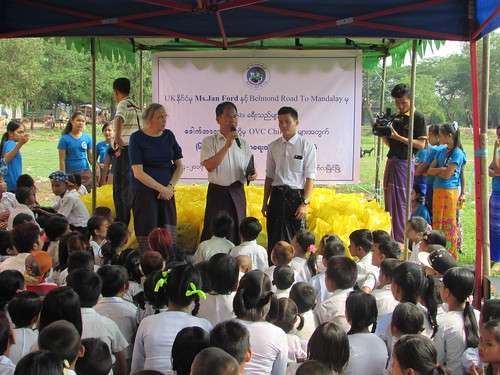
Doctor Hla Tun talks about the 'Road to Mandalay' ship and the educational support work carried out.
One assistant collected the vouchers as each child game up, sometimes requiring a hunt in the bag containing the cake and drink before it was located. Other staff clambered around the stage looking for the appropriate type of yellow bag which was then handed to me to present to the child.
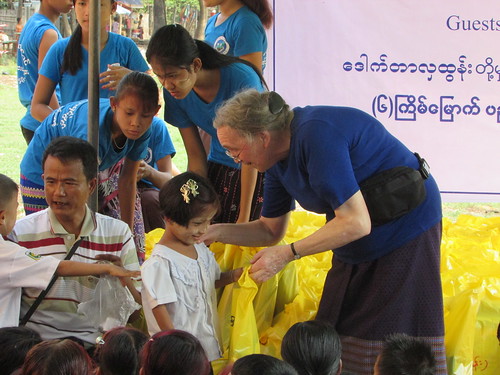
Hlaing Drop In Centre - 2017.
Mistakes were occasionally made in identifying the correct type of bag for a child, particularly with girls with short-cropped hair and shorts. Then the cry would go up from the voucher collector, in Myanmar language, "Boy, Boy!" or 'Girl, Girl!". I even learnt the words myself and joined in the shout although I forgot them immediately the presentation was done.
Many, many photographs were taken: members of staff of the Drop In Centre each wanted their personal record on camera or mobile phone. This was a very special once-a-year event for both the staff and children involved.
Once the children were wearing their new uniforms, sometimes over their everyday clothes, a series of pictures of the whole group was taken.
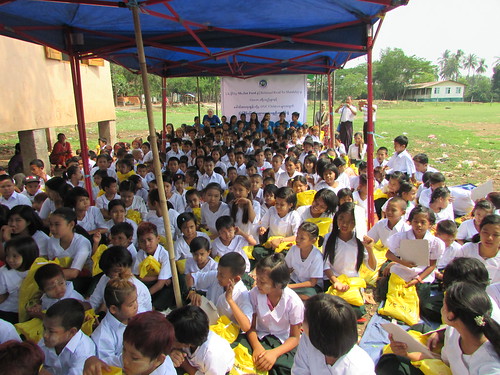
Hlaing Drop In Centre - 2017: Group photograph.
As the happy children departed, we returned to the Drop In Centre and Doctor Hla Tun addressed all the staff.
Then, it was back to our hotel. Whilst Doctor Hla Tun's mother was preparing to leave, the helpful Care Myanmar manager who'd assisted us, the Doctor and I went to a nearby teashop for discussions.
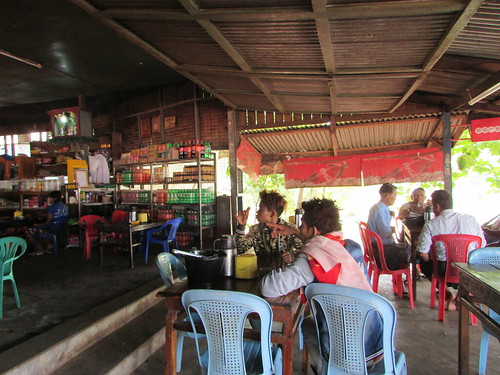
Teashop near our hotel.
When we finally checked-out of the hotel, the friendly porter insisted on taking our photographs in front of two detailed wooden models of bullock carts displayed by the hotel.
We were then driven to the Mawlamyine offices of the Care Myanmar charity - not the rather cramped offices I'd visited in previous years but a much larger, modern property necessitated by the number of projects being handled. In addition to the Orphans and Vulnerable Children (OVC) project there are projects to develop rubber-growing and combat Human Trafficking.
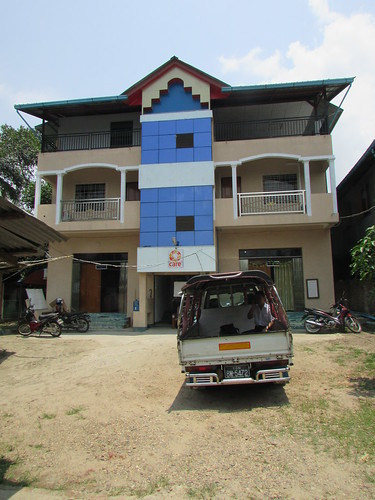
Care Myanmar Offices, Mawlamyine.
One ground floor entrance was for the 'Finance and Admin & Logistics Team' another 'Global Fund'. After a brief wait, the pick up then drove us to the Shwe Zee Kyet restaurant - a large, upmarket, rather Western version of the tea shop with a sound system playing pop music. There were few diners whilst we took our lunch but I imagine it becomes crowded in the evening: Myanmar people seem inherently sociable.
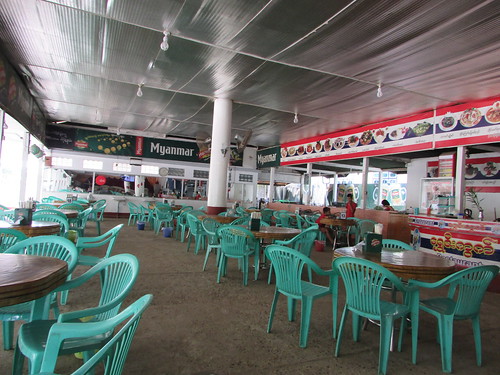 Shwe Zee Kyet restaurant.
Shwe Zee Kyet restaurant.
Back at the Care Myanmar offices, the Doctor's Mother and I were invited to rest in a separate, upstairs bedroom. I assume that this bedroom was intended for visiting foreigners for, in addition to the usual sleeping mats, there was one mattress two inches thick, air conditioning and an en-suite shower with Western-style toilet.
I enjoyed resting here before we carried out our final distribution in Mon State at the Shwe Myaing Thiri Drop In Centre. Once again, we had seen many of the staff and children on previous visits. After Doctor Hla Tun addressed the children, I was required to add my words of explanation and encouragement. The donated items are tailored to the needed of each Drop In Centre (within the constraints of a limited budget) so here the children received both uniforms and umbrella, proudly displayed for the 'group shot'.
We were able to return to the Care Myanmar offices for more relaxation, with the inevitable visit on the way to a surprisingly-clean teashop.
Our work complete, the pick-up truck was loaded with our luggage for the final time. We made visits to the three most famous pagodas in Mawlamyine before stopping at another restaurant for a farewell dinner with two of our friends from Care Myanmar. There was just time to drive to the PTT offices to load our luggage and board the 10 p.m. bus to Yangon, with one restaurant stop near Kyaikto. I still didn't exactly enjoy the ride but seven and a half hours was decidedly less demanding than the thirteen and a half hour ride it had taken to reach Dawei on the way south.
We had made distributions to 1,282 children in Mon State, as follows:-
Yaye Township 422 children in total at
La Mine 45 children
Ko Dut 329 children
Mok Ka Nin 48 children
Mudon Township 258 children in total at
Ka Mar Wet 37 children
Mudon 142 children
Kot Kha Pon 79 children
Mawlamyine Township 602 children in total at
Hlaing 427 children
Shwe Myaing Thiri 175 children
Related Posts on this Website
Next post describing this trip.
All 2017 Trip posts.
My Pictures
Where necessary, clicking on an image above will display an 'uncropped' view or, alternately, pictures may be selected, viewed or downloaded, in various sizes, from the albums listed:-
Kaung Myat Hotel, Mawlamyine.
Hlaing Drop In Centre - 2017.
Around Mawlamyine - 2017.
Care Myanmar Offices, Mawlamyine.
Shwe Myaing Thin Drop In Centre - 2017.
[Pictures added to text 19-Jul-2017]






















